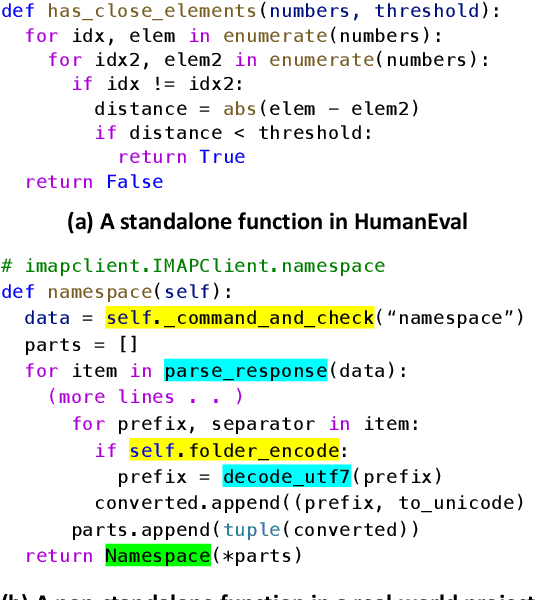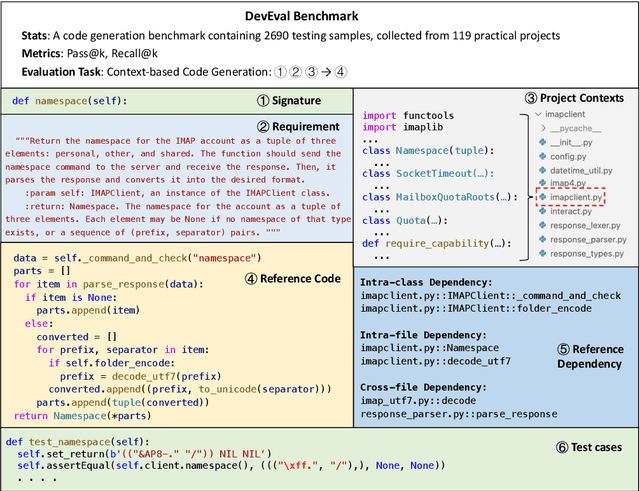Huanyu Liu
SATURN: SAT-based Reinforcement Learning to Unleash Language Model Reasoning
May 22, 2025Abstract:How to design reinforcement learning (RL) tasks that effectively unleash the reasoning capability of large language models (LLMs) remains an open question. Existing RL tasks (e.g., math, programming, and constructing reasoning tasks) suffer from three key limitations: (1) Scalability. They rely heavily on human annotation or expensive LLM synthesis to generate sufficient training data. (2) Verifiability. LLMs' outputs are hard to verify automatically and reliably. (3) Controllable Difficulty. Most tasks lack fine-grained difficulty control, making it hard to train LLMs to develop reasoning ability from easy to hard. To address these limitations, we propose Saturn, a SAT-based RL framework that uses Boolean Satisfiability (SAT) problems to train and evaluate LLM reasoning. Saturn enables scalable task construction, rule-based verification, and precise difficulty control. Saturn designs a curriculum learning pipeline that continuously improves LLMs' reasoning capability by constructing SAT tasks of increasing difficulty and training LLMs from easy to hard. To ensure stable training, we design a principled mechanism to control difficulty transitions. We introduce Saturn-2.6k, a dataset of 2,660 SAT problems with varying difficulty. It supports the evaluation of how LLM reasoning changes with problem difficulty. We apply Saturn to DeepSeek-R1-Distill-Qwen and obtain Saturn-1.5B and Saturn-7B. We achieve several notable results: (1) On SAT problems, Saturn-1.5B and Saturn-7B achieve average pass@3 improvements of +14.0 and +28.1, respectively. (2) On math and programming tasks, Saturn-1.5B and Saturn-7B improve average scores by +4.9 and +1.8 on benchmarks (e.g., AIME, LiveCodeBench). (3) Compared to the state-of-the-art (SOTA) approach in constructing RL tasks, Saturn achieves further improvements of +8.8%. We release the source code, data, and models to support future research.
FANformer: Improving Large Language Models Through Effective Periodicity Modeling
Feb 28, 2025Abstract:Periodicity, as one of the most important basic characteristics, lays the foundation for facilitating structured knowledge acquisition and systematic cognitive processes within human learning paradigms. However, the potential flaws of periodicity modeling in Transformer affect the learning efficiency and establishment of underlying principles from data for large language models (LLMs) built upon it. In this paper, we demonstrate that integrating effective periodicity modeling can improve the learning efficiency and performance of LLMs. We introduce FANformer, which integrates Fourier Analysis Network (FAN) into attention mechanism to achieve efficient periodicity modeling, by modifying the feature projection process of attention mechanism. Extensive experimental results on language modeling show that FANformer consistently outperforms Transformer when scaling up model size and training tokens, underscoring its superior learning efficiency. To further validate the effectiveness of FANformer, we pretrain a FANformer-1B on 1 trillion tokens. FANformer-1B exhibits marked improvements on downstream tasks compared to open-source LLMs with similar model parameters or training tokens. The results position FANformer as an effective and promising architecture for advancing LLMs.
aiXcoder-7B: A Lightweight and Effective Large Language Model for Code Completion
Oct 17, 2024Abstract:Large Language Models (LLMs) have been widely used in code completion, and researchers are focusing on scaling up LLMs to improve their accuracy. However, larger LLMs will increase the response time of code completion and decrease the developers' productivity. In this paper, we propose a lightweight and effective LLM for code completion named aiXcoder-7B. Compared to existing LLMs, aiXcoder-7B achieves higher code completion accuracy while having smaller scales (i.e., 7 billion parameters). We attribute the superiority of aiXcoder-7B to three key factors: (1) Multi-objective training. We employ three training objectives, one of which is our proposed Structured Fill-In-the-Middle (SFIM). SFIM considers the syntax structures in code and effectively improves the performance of LLMs for code. (2) Diverse data sampling strategies. They consider inter-file relationships and enhance the capability of LLMs in understanding cross-file contexts. (3) Extensive high-quality data. We establish a rigorous data collection pipeline and consume a total of 1.2 trillion unique tokens for training aiXcoder-7B. This vast volume of data enables aiXcoder-7B to learn a broad distribution of code. We evaluate aiXcoder-7B in five popular code completion benchmarks and a new benchmark collected by this paper. The results show that aiXcoder-7B outperforms the latest six LLMs with similar sizes and even surpasses four larger LLMs (e.g., StarCoder2-15B and CodeLlama-34B), positioning aiXcoder-7B as a lightweight and effective LLM for academia and industry. Finally, we summarize three valuable insights for helping practitioners train the next generations of LLMs for code. aiXcoder-7B has been open-souced and gained significant attention. As of the submission date, aiXcoder-7B has received 2,193 GitHub Stars.
DevEval: A Manually-Annotated Code Generation Benchmark Aligned with Real-World Code Repositories
May 30, 2024Abstract:How to evaluate the coding abilities of Large Language Models (LLMs) remains an open question. We find that existing benchmarks are poorly aligned with real-world code repositories and are insufficient to evaluate the coding abilities of LLMs. To address the knowledge gap, we propose a new benchmark named DevEval, which has three advances. (1) DevEval aligns with real-world repositories in multiple dimensions, e.g., code distributions and dependency distributions. (2) DevEval is annotated by 13 developers and contains comprehensive annotations (e.g., requirements, original repositories, reference code, and reference dependencies). (3) DevEval comprises 1,874 testing samples from 117 repositories, covering 10 popular domains (e.g., Internet, Database). Based on DevEval, we propose repository-level code generation and evaluate 8 popular LLMs on DevEval (e.g., gpt-4, gpt-3.5, StarCoder 2, DeepSeek Coder, CodeLLaMa). Our experiments reveal these LLMs' coding abilities in real-world code repositories. For example, in our experiments, the highest Pass@1 of gpt-4-turbo is only 53.04%. We also analyze LLMs' failed cases and summarize their shortcomings. We hope DevEval can facilitate the development of LLMs in real code repositories. DevEval, prompts, and LLMs' predictions have been released.
Generalization or Memorization: Data Contamination and Trustworthy Evaluation for Large Language Models
Feb 24, 2024Abstract:Recent statements about the impressive capabilities of large language models (LLMs) are usually supported by evaluating on open-access benchmarks. Considering the vast size and wide-ranging sources of LLMs' training data, it could explicitly or implicitly include test data, leading to LLMs being more susceptible to data contamination. However, due to the opacity of training data, the black-box access of models, and the rapid growth of synthetic training data, detecting and mitigating data contamination for LLMs faces significant challenges. In this paper, we propose CDD, which stands for Contamination Detection via output Distribution for LLMs. CDD necessitates only the sampled texts to detect data contamination, by identifying the peakedness of LLM's output distribution. To mitigate the impact of data contamination in evaluation, we also present TED: Trustworthy Evaluation via output Distribution, based on the correction of LLM's output distribution. To facilitate this study, we introduce two benchmarks, i.e., DetCon and ComiEval, for data contamination detection and contamination mitigation evaluation tasks. Extensive experimental results show that CDD achieves the average relative improvements of 21.8\%-30.2\% over other contamination detection approaches in terms of Accuracy, F1 Score, and AUC metrics, and can effectively detect contamination caused by the variants of test data. TED significantly mitigates performance improvements up to 66.9\% attributed to data contamination across 24 settings and 21 contamination degrees. In real-world applications, we reveal that ChatGPT exhibits a high potential to suffer from data contamination on HumanEval benchmark.
DevEval: Evaluating Code Generation in Practical Software Projects
Jan 26, 2024



Abstract:How to evaluate Large Language Models (LLMs) in code generation is an open question. Many benchmarks have been proposed but are inconsistent with practical software projects, e.g., unreal program distributions, insufficient dependencies, and small-scale project contexts. Thus, the capabilities of LLMs in practical projects are still unclear. In this paper, we propose a new benchmark named DevEval, aligned with Developers' experiences in practical projects. DevEval is collected through a rigorous pipeline, containing 2,690 samples from 119 practical projects and covering 10 domains. Compared to previous benchmarks, DevEval aligns to practical projects in multiple dimensions, e.g., real program distributions, sufficient dependencies, and enough-scale project contexts. We assess five popular LLMs on DevEval (e.g., gpt-4, gpt-3.5-turbo, CodeLLaMa, and StarCoder) and reveal their actual abilities in code generation. For instance, the highest Pass@1 of gpt-3.5-turbo only is 42 in our experiments. We also discuss the challenges and future directions of code generation in practical projects. We open-source DevEval and hope it can facilitate the development of code generation in practical projects.
Flowmind2Digital: The First Comprehensive Flowmind Recognition and Conversion Approach
Jan 08, 2024Abstract:Flowcharts and mind maps, collectively known as flowmind, are vital in daily activities, with hand-drawn versions facilitating real-time collaboration. However, there's a growing need to digitize them for efficient processing. Automated conversion methods are essential to overcome manual conversion challenges. Existing sketch recognition methods face limitations in practical situations, being field-specific and lacking digital conversion steps. Our paper introduces the Flowmind2digital method and hdFlowmind dataset to address these challenges. Flowmind2digital, utilizing neural networks and keypoint detection, achieves a record 87.3% accuracy on our dataset, surpassing previous methods by 11.9%. The hdFlowmind dataset, comprising 1,776 annotated flowminds across 22 scenarios, outperforms existing datasets. Additionally, our experiments emphasize the importance of simple graphics, enhancing accuracy by 9.3%.
Coarse to Fine: Video Retrieval before Moment Localization
Oct 14, 2021


Abstract:The current state-of-the-art methods for video corpus moment retrieval (VCMR) often use similarity-based feature alignment approach for the sake of convenience and speed. However, late fusion methods like cosine similarity alignment are unable to make full use of the information from both query texts and videos. In this paper, we combine feature alignment with feature fusion to promote the performance on VCMR.
High-Order Information Matters: Learning Relation and Topology for Occluded Person Re-Identification
Apr 02, 2020



Abstract:Occluded person re-identification (ReID) aims to match occluded person images to holistic ones across dis-joint cameras. In this paper, we propose a novel framework by learning high-order relation and topology information for discriminative features and robust alignment. At first, we use a CNN backbone and a key-points estimation model to extract semantic local features. Even so, occluded images still suffer from occlusion and outliers. Then, we view the local features of an image as nodes of a graph and propose an adaptive direction graph convolutional (ADGC)layer to pass relation information between nodes. The proposed ADGC layer can automatically suppress the message-passing of meaningless features by dynamically learning di-rection and degree of linkage. When aligning two groups of local features from two images, we view it as a graph matching problem and propose a cross-graph embedded-alignment (CGEA) layer to jointly learn and embed topology information to local features, and straightly predict similarity score. The proposed CGEA layer not only take full use of alignment learned by graph matching but also re-place sensitive one-to-one matching with a robust soft one. Finally, extensive experiments on occluded, partial, and holistic ReID tasks show the effectiveness of our proposed method. Specifically, our framework significantly outperforms state-of-the-art by6.5%mAP scores on Occluded-Duke dataset.
An End-to-End Network for Panoptic Segmentation
Mar 13, 2019



Abstract:Panoptic segmentation, which needs to assign a category label to each pixel and segment each object instance simultaneously, is a challenging topic. Traditionally, the existing approaches utilize two independent models without sharing features, which makes the pipeline inefficient to implement. In addition, a heuristic method is usually employed to merge the results. However, the overlapping relationship between object instances is difficult to determine without sufficient context information during the merging process. To address the problems, we propose a novel end-to-end network for panoptic segmentation, which can efficiently and effectively predict both the instance and stuff segmentation in a single network. Moreover, we introduce a novel spatial ranking module to deal with the occlusion problem between the predicted instances. Extensive experiments have been done to validate the performance of our proposed method and promising results have been achieved on the COCO Panoptic benchmark.
 Add to Chrome
Add to Chrome Add to Firefox
Add to Firefox Add to Edge
Add to Edge